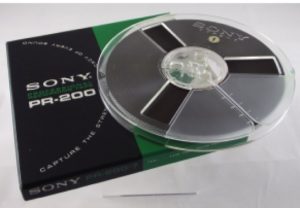History (1949): Quarter-Inch Open Reel Tape
First commercial tape recorder: Ampex model 200
This is a Press Release edited by StorageNewsletter.com on October 22, 2018 at 2:32 pmThis article was published by the Museum of Obsolete Media.
Quarter-inch open reel tape (1949-1980s)

Open reel tape for professional use was first developed in the 1930s in Germany, and after the war the technology was taken to America by Jack Mullin and developed commercially by Ampex with investment from Bing Crosby.
The first commercial tape recorder (the Ampex Model 200) was released in 1948, and open reel tape recording was the main recording format used by professional recording studios until the late 1980s.
Inexpensive open reel tape recorders became available around 1949, and were widely used for voice recording and music playback in the home and in schools before the Compact Cassette gradually took over.
Domestic tape recorders used quarter-inch tape with speeds of 1 7/8 inches per second, 3 3/4 inches per second, or 7 1/2 inches per second. Faster speeds allowed better fidelity, but used more tape.
Reels were up to seven inches in diameter, most commonly with plastic reels but metal was also used, which fitted over a splined quarter-inch shaft known as a cine spindle. The most common reel sizes were seven, five and three inches in diameter.
Pre-recorded open-reel tapes were introduced to Great Britain in 1952 (having been introduced in the US in 1949), and they reached the peak of their popularity in the mid-1960s before being eclipsed by 8-track and Compact Cassette.
For a while in the 1970s, quadraphonic open reel tape (both blank and pre-recorded) was available.
By the late 1970s though, pre-recorded open reel tapes had almost disappeared, and the final releases were in the mid-1980s, catering for the audiophile market.














 Subscribe to our free daily newsletter
Subscribe to our free daily newsletter

